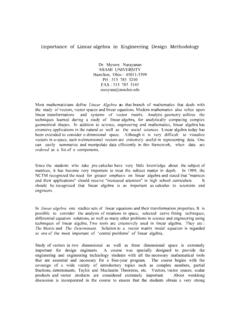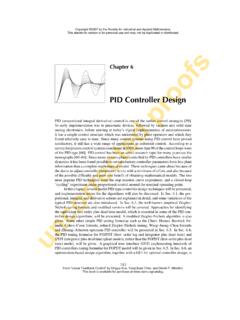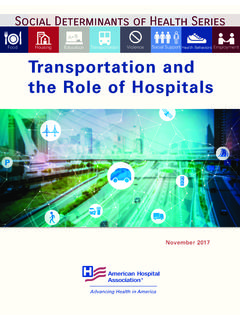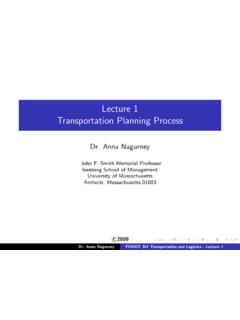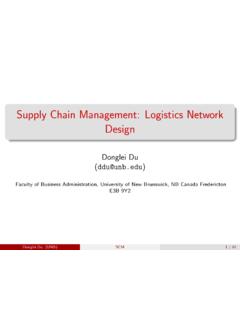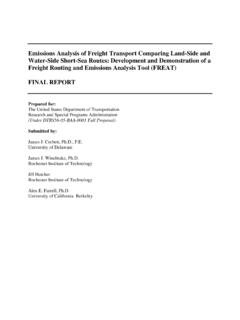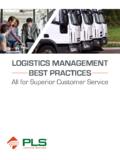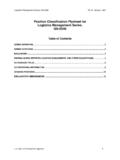Transcription of THE ROLE OF TRANSPORTATION IN LOGISTICS CHAIN
1 THE ROLE OF TRANSPORTATION IN LOGISTICS CHAIN Yung-yu TSENG PhD Candidate Transport Systems Centre University of South Australia GPO Box 2471 Adelaide, South Australia 5001 Australia Fax: +61-8-8302-1880 Email: Wen Long YUE Program Director Transport Systems Centre University of South Australia GPO Box 2471 Adelaide, South Australia 5001 Australia Fax: +61-8-8302-1880 Email: Michael A P TAYLOR Director Transport Systems Centre University of South Australia GPO Box 2471 Adelaide, South Australia 5001 Australia Fax: +61-8-8302 1880 Email: Abstract: The operation of TRANSPORTATION determines the efficiency of moving products. The progress in techniques and management principles improves the moving load, delivery speed, service quality, operation costs, the usage of facilities and energy saving. TRANSPORTATION takes a crucial part in the manipulation of logistic. Reviewing the current condition, a strong system needs a clear frame of LOGISTICS and a proper transport implements and techniques to link the producing procedures.
2 The objective of the paper is to define the role of TRANSPORTATION in LOGISTICS for the reference of further improvement. The research was undertaken to assist LOGISTICS managers, researchers and TRANSPORTATION planners to define and comprehend the basic views of LOGISTICS and its various applications and the relationships between LOGISTICS and TRANSPORTATION . Key Words: LOGISTICS , TRANSPORTATION , City LOGISTICS 1. INTRODUCTION Since LOGISTICS advanced from 1950s, there were numerous researches focused on this area in different applications. Due to the trend of nationalisation and globalisation in recent decades, the importance of LOGISTICS management has been growing in various areas. For industries, LOGISTICS helps to optimise the existing production and distribution processes based on the same resources through management techniques for promoting the efficiency and competitiveness of enterprises.
3 The key element in a LOGISTICS CHAIN is TRANSPORTATION system, which joints the separated activities. TRANSPORTATION occupies one-third of the amount in the LOGISTICS costs and TRANSPORTATION systems influence the performance of LOGISTICS system hugely. Transporting is required in the whole production procedures, from manufacturing to delivery to the final consumers and returns. Only a good coordination between each component would bring the benefits to a maximum. The purpose of this paper is to re-clarify and redefine the position relationship between TRANSPORTATION and LOGISTICS systems through collecting and analysing various application Proceedings of the Eastern Asia Society for TRANSPORTATION Studies, Vol. 5, pp. 1657 - 1672, 20051657cases and practices in LOGISTICS from literatures. It is to provide a general framework and expect to be referred for further development and researches.
4 The paper started from introducing the development of LOGISTICS and transport-related sectors based on a historical review. Afterwards it discussed the interrelationships of TRANSPORTATION and LOGISTICS . It expresses the benefits that TRANSPORTATION brings to LOGISTICS activities and vice versa. For instance the increase of the efficiency of LOGISTICS also would bestead to release traffic load in the urban areas. Furthermore, some major LOGISTICS activities and concepts were also discussed in this paper. It especially presents City LOGISTICS independently due to it is considered as a main tendency and an available method of future integration of transport and LOGISTICS in the urban areas. Finally, this paper will discuss and conclude the potential further development of LOGISTICS systems. 2. OVERVIEW OF LOGISTICS Definitions Council of LOGISTICS Management (1991) defined that LOGISTICS is part of the supply CHAIN process that plans, implements, and controls the efficient, effective forward and reverse flow and storage of goods, services, and related information between the point of origin and the point of consumption in order to meet customers requirements.
5 Johnson and Wood s definition (cited in Tilanus, 1997) uses five important key terms , which are LOGISTICS , inbound LOGISTICS , materials management, physical distribution, and supply- CHAIN management, to interpret. LOGISTICS describes the entire process of materials and products moving into, through, and out of firm. Inbound LOGISTICS covers the movement of material received from suppliers. Materials management describes the movement of materials and components within a firm. Physical distribution refers to the movement of goods outward from the end of the assembly line to the customer. Finally, supply- CHAIN management is somewhat larger than LOGISTICS , and it links LOGISTICS more directly with the user s total communications network and with the firm s engineering staff. The commonality of the recent definitions is that LOGISTICS is a process of moving and handling goods and materials, from the beginning to the end of the production, sale process and waste disposal, to satisfy customers and add business competitiveness.
6 It is the process of anticipating customer needs and wants; acquiring the capital, materials, people, technologies, and information necessary to meet those needs and wants; optimising the goods- or service-producing network to fulfil customer requests; and utilizing the network to fulfil customer requests in a timely way (Tilanus, 1997). Simply to say, LOGISTICS is customer-oriented operation management . Components of LOGISTICS System Figure 1 provides an overview of the LOGISTICS system. LOGISTICS services, information systems and infrastructure/resources are the three components of this system and closely linked. The interaction of the three main components in the LOGISTICS system is interpreted as follows. LOGISTICS services support the movement of materials and products from inputs through production to consumers, as well as associated waste disposal and reverse flows. They include activities undertaken in-house by the users of the services ( storage or inventory control at a manufacturer s plant) and the operations of external service providers.
7 Proceedings of the Eastern Asia Society for TRANSPORTATION Studies, Vol. 5, pp. 1657 - 1672, 20051658 LOGISTICS services comprise physical activities ( transport, storage) as well as non-physical activities ( supply CHAIN design, selection of contractors, freightage negotiations). Most activities of LOGISTICS services are bi-direction. Information systems include modelling and management of decision making, and more important issues are tracking and tracing. It provides essential data and consultation in each step of the interaction among LOGISTICS services and the target stations. Infrastructure comprises human resources, financial resources, packaging materials, warehouses, transport and communications. Most fixed capital is for building those infrastructures. They are concrete foundations and basements within LOGISTICS systems. Figure 1. Overview of LOGISTICS System (source: BTRE, 2001) History and Advancement of LOGISTICS LOGISTICS was initially a military activity concerned with getting soldiers and munitions to the battlefront in time for flight, but it is now seen as an integral part of the modern production process.
8 The main background of its development is that the recession of America in the 1950s caused the industrial to place importance on goods circulations. The term, LOGISTICS , was initially developed in the context of military activities in the late 18th and early 19th centuries and it launched from the military LOGISTICS of World War II. The probable origin of the term is the Greek logistikos, meaning skilled in calculating . (BTRE, 2001) Military definitions typically incorporate the supply, movement and quartering of troops in a set. And now, a number of researches were taken and made LOGISTICS applications from military Proceedings of the Eastern Asia Society for TRANSPORTATION Studies, Vol. 5, pp. 1657 - 1672, 20051659activities to business activities. Business LOGISTICS was not an academic subject until the 1960s. A key element of LOGISTICS , the trade-off between transport and inventory costs, was formally recognized in economics at least as early as the mid-1880s.
9 (BTRE, 2001) Based on the American experience, the development of LOGISTICS could be divided into four periods (Chang, 1998), which are represented as Figure 2. Figure 2. LOGISTICS historical development Before the 1950s, LOGISTICS was under the dormant condition. Production was the main part of the managers concerned, and industry LOGISTICS was once regarded as necessary evil in this period. During the 1950s to and 1960s, applying new ideas of administration on business was a tendency. Drucker (2001), who thought LOGISTICS was The Economy s Dark Continent, regarded the procedure of physical distribution after producing products as the most possible development area in American businesses but also the most neglected area. Lewis s study (cited in Chang, 1998) in 1956 on the role of air TRANSPORTATION in physical distribution was the application of total cost concept and it pointed out the notions of trade-off between inventory and TRANSPORTATION .
10 From the 1970s onwards, more and more applications and researches of LOGISTICS appeared. Due to petroleum price rise in 1973, the effects of LOGISTICS activities on enterprises grew. Slow growth of market, pressure of high stagflation, release of TRANSPORTATION control, and competitions of the third world on products and materials all increased the significance of LOGISTICS system on planning and business at that time. The further tendency of LOGISTICS in the early 21st century is LOGISTICS alliance, Third Party LOGISTICS (TPL) and globalised LOGISTICS . LOGISTICS circulation is an essential of business activities and sustaining competitiveness, however, to conduct and manage a large company is cost consuming and not economic. Therefore, alliance of international industries could save working costs and cooperation with TPL could specialize in LOGISTICS area. 3. INTERRELATIONSHIPS BETWEEN TRANSPORTATION AND LOGISTICS Without well developed TRANSPORTATION systems, LOGISTICS could not bring its advantages into full play.

